A Study of the Three-Body Abrasive Wear Resistance of 5V/5Nb-5Cr-5Mo-5W-5Co-Fe Multicomponent Cast Alloys with Different Carbon Percentages
Abstract
1. Introduction
2. Materials and Methods
2.1. Preparation of Alloys
2.2. Microstructure Evaluation
2.3. Measurement of Materials’ Hardness Level
2.4. Abrasion Wear Test
3. Results and Discussion
3.1. Microstructure Characteristics and Hardness
3.2. Three-Body Abrasive Wear Characteristics of the Alloys
3.3. Three-Body Abrasive Wear Mechanism
4. Conclusions
- There are several types of carbides precipitated in the microstructures of the studied alloys, for which the shape and type strongly depend on the chemical composition.
- The CVF increases as the amount of C addition increases. Therefore, the carbide’s space might be denser, making it difficult for the silica sand to abrade the matrix area leading to improved wear resistance properties.
- There is no significant difference in the hardness between the two alloys (5V and 5Nb) with the same amount of C due to relatively similar CVF values.
- The NbC carbide’s larger size, in comparison to VC, produced better wear resistance. Therefore, the 2C-5Nb alloy presents the best three-body abrasive wear resistance behavior among all the alloys studied.
Author Contributions
Funding
Institutional Review Board Statement
Informed Consent Statement
Data Availability Statement
Conflicts of Interest
References
- Holmberg, K.; Erdemir, A. Influence of tribology on global energy consumption, cost and emissions. Friction 2017, 5, 263–284. [Google Scholar] [CrossRef]
- Tylczak, J.H. Abrasive Wear ASM Handbook; ASM International: Materials Park, OH, USA, 1992. [Google Scholar]
- Watson, J.D.; Mutton, P.J.; Sare, I.R. Abrasive wear of white cast irons. Met. Forum 1980, 3, 74–88. [Google Scholar]
- Todaka, T.; Shimizu, K.; Kusumoto, K.; Purba, R.H.; Gaqi, Y. Efect of carbon content on three-body abrasive wear characteristics of 28Cr-3Ni cast alloys. ISIJ Int. 2021, 61, 2274–2283. [Google Scholar] [CrossRef]
- Gundlach, R.B.; Parks, J.L. Influence of abrasive hardness on the wear resistance of high chromium irons. Wear 1978, 46, 97–108. [Google Scholar] [CrossRef]
- Dogan, O.N.; Laird, G.; Hawk, J.A. Solidification structure and abrasion resistance of high chromium white cast irons. Metall. Meter. Trans. A 1997, 28A, 1315–1328. [Google Scholar] [CrossRef]
- Jokari-Sheshdeh, M.; Ali, Y.; Gallo, S.C.; Lin, W.; Gates, J.D. Comparing the abrasion performance of NiHard-4 and high-Cr-Mo white cast irons: The effects of chemical composition and microstructure. Wear 2022, 492–493, 204208. [Google Scholar] [CrossRef]
- Zum Gahr, K.H.; Eldis, G.T. Abrasive wear of white cast irons. Wear 1980, 64, 175–194. [Google Scholar] [CrossRef]
- Gahlin, R.; Jacobson, S. The particle size effect in abrasion studied by controlled abrasive surfaces. Wear 1999, 224, 118–125. [Google Scholar] [CrossRef]
- Woldman, M.; van der Heide, E.; Schipper, D.J.; Tinga, T.; Masen, M.A. Investigating the influence of sand particle properties on abrasive wear behaviour. Wear 2012, 294–295, 419–426. [Google Scholar] [CrossRef]
- Berns, H.; Fischer, A. Microstructure of Fe-Cr-C hardfacing alloys with additions of Nb, Ti and, B. Metallography 1987, 20, 401–429. [Google Scholar] [CrossRef]
- Chung, R.J.; Tang, X.; Li, D.Y.; Hinckley, B.; Dolman, K. Effect of titanium addition on the microstructure and wear resistance of hypereutectic high chromium cast iron Fe-25wt.%Cr-4wt.%C. Wear 2009, 267, 356–361. [Google Scholar] [CrossRef]
- Purba, R.H.; Shimizu, K.; Kusumoto, K.; Gaqi, Y.; Todaka, T. Effect of boron addition on three-body abrasive wear characteristics of high chromium based multi-component white cast iron. Materials chemistry and physics. Mater. Chem. Phys. 2022, 275, 125232. [Google Scholar] [CrossRef]
- Tabrett, C.P.; Sare, I.R. The effect of heat treatment on the abrasion resistance of alloy white cast irons. Wear 1997, 203–204, 206–219. [Google Scholar] [CrossRef]
- Karantzalis, A.E.; Lekatou, A.; Mavros, H. Microstructure modification of as-cast high chromium white cast iron by heat treatment. J. Mater. Eng. Perform. 2009, 18, 174–181. [Google Scholar] [CrossRef]
- Karantzalis, E.; Lekatou, A.; Mavros, H. Microstructure and properties of high chromium cast irons: Effect of heat treatments and alloying additions. Int. J. Cast Met. Res. 2009, 22, 448–456. [Google Scholar] [CrossRef]
- Coronado, J.J. Effect of (Fe, Cr)7C3 carbide orientation on abrasion wear resistance and fracture toughness. Wear 2011, 270, 287–293. [Google Scholar] [CrossRef]
- Filipovic, M.; Kamberovic, Z.; Korac, M.; Jordovic, B. Effect of niobium and vanadium additions on as-cast microstructure and properties of hypoeutectic Fe-Cr-C alloy. ISIJ Int. 2013, 53, 2160–2166. [Google Scholar] [CrossRef]
- Bedolla-Jacuinde, A.; Correa, R.; Mejia, I.; Quezada, J.G.; Rainforth, W.M. The effect of titanium on the wear behaviour of a 16%Cr white cast iron under pure sliding. Wear 2007, 263, 808–820. [Google Scholar] [CrossRef]
- Zhu, C.; Fordyce, I.; Sun, S.D.; Annasamy, M.; Fabijanic, D.; Short, K.; Paradowska, A.; Leary, M.; Brandt, M.; Easton, M. Effect of Ti and TiC additions on the microstructure and wear resistance of high chromium white irons produced by laser directed energy deposition. Wear 2022, 510–511, 204519. [Google Scholar] [CrossRef]
- Shimizu, K.; Kusumoto, K.; Yaer, X.; Zhang, Y.; Shirai, M. Effect of Mo content on erosive wear characteristics of high chromium cast iron at 1173 K. Wear 2017, 376–377, 542–548. [Google Scholar] [CrossRef]
- Anijdan, S.H.M.; Bahrami, A.; Varahram, N.; Davami, P. Effect of tungsten on erosion-corrosion behavior of high chromium white cast iron. Mater. Sci. Eng. A 2007, 454–455, 623–628. [Google Scholar] [CrossRef]
- Matsubara, Y.; Sasaguri, N.; Shimizu, K.; Yu, S.K. Solidification and abrasion wear of white cast irons alloyed with 20% carbide forming elements. Wear 2001, 250, 502–510. [Google Scholar] [CrossRef]
- de Mello, J.D.B.; Polycarpou, A.A. Abrasive wear mechanism of multi-components ferrous alloys abraded by soft, fine abrasive particles. Wear 2010, 269, 911–920. [Google Scholar] [CrossRef]
- Kusumoto, K.; Shimizu, K.; Yaer, X.; Zhang, Y.; Ota, Y.; Ito, J. Abrasive wear characteristics of Fe-2C-5Cr-5Mo-5W-5Nb multi-component white cast iron. Wear 2017, 376–377, 22–29. [Google Scholar] [CrossRef]
- Kusumoto, K.; Shimizu, K.; Yaer, X.; Hara, H.; Tamura, K.; Kawai, H. High erosion-oxidation performance of Fe-based Nb or V containing multicomponent alloys with Co addition at 1173 K. Mater. Des. 2015, 88, 366–374. [Google Scholar] [CrossRef]
- Inthidech, S.; Chooprajong, A.; Sricharoenchai, P.; Matsubara, Y. Two-body and three-body types abrasive wear behavior of hypoeutectic 26 mass% Cr cast irons with molybdenum. Mater. Trans. 2012, 53, 1258–12566. [Google Scholar] [CrossRef]
- Fordyce, I.; Annasamy, M.; Sun, S.D.; Fabijanic, D.; Gallo, S.C.; Leary, M.; Easton, M.; Brandt, M. The effect of heat treatment on the abrasive wear and erosive wear behavior of laser metal deposite Fe-28Cr-2.7C alloy. Wear 2020, 458–459, 203410. [Google Scholar] [CrossRef]
- Shimizu, K.; Purba, R.H.; Kusumoto, K.; Year, X.; Ito, J.; Kasuga, H.; Gaqi, Y. Microstructural evaluation and high-temperature erosion characteristic of high chromium cast irons. Wear 2019, 426–427, 420–427. [Google Scholar] [CrossRef]
- Wang, J.; Li, C.; Liu, H.; Yang, H.; Shen, B.; Gao, S.; Huang, S. The precipitation and transformation of secondary carbides in high chromium cast iron. Mater. Charact. 2006, 56, 73–78. [Google Scholar] [CrossRef]
- Kishore, K.; Kumar, U.; Dinesh, N.; Adhikary, M. Effect of soaking temperature on carbide precipitation, hardness, and wear resistance of high chromium cast iron. J. Fail. Anal. Prev. 2020, 20, 249–260. [Google Scholar] [CrossRef]
- Purba, R.H.; Shimizu, K.; Kusumoto, K.; Gaqi, Y.; Huq, M.J. Tribological Characteristics of High-Chromium Based Multi-Component White Cast Irons. Crystals 2022, 12, 1488. [Google Scholar] [CrossRef]
- Tong, J.M.; Zhou, Y.-Z.; Sheng, T.Y.; Deng, H.J. The influence of retained austenite in high chromium cast iron on impact-abrasive wear. Wear 1990, 135, 217–226. [Google Scholar] [CrossRef]
- Xi, J.T.; Zhou, Q.D.; Liu, S.H.; Song, G.S. Influence of retained austenite on wear resistance of high chromium cast iron under various impact loads. Wear 1993, 162–164, 83–88. [Google Scholar] [CrossRef]
- Wang, Y.P.; Li, D.Y.; Parent, I.; Tian, H. Improving the wear resistance of white cast iron using a new concept-high-entropy microstructure. Wear 2011, 271, 1623–1628. [Google Scholar] [CrossRef]
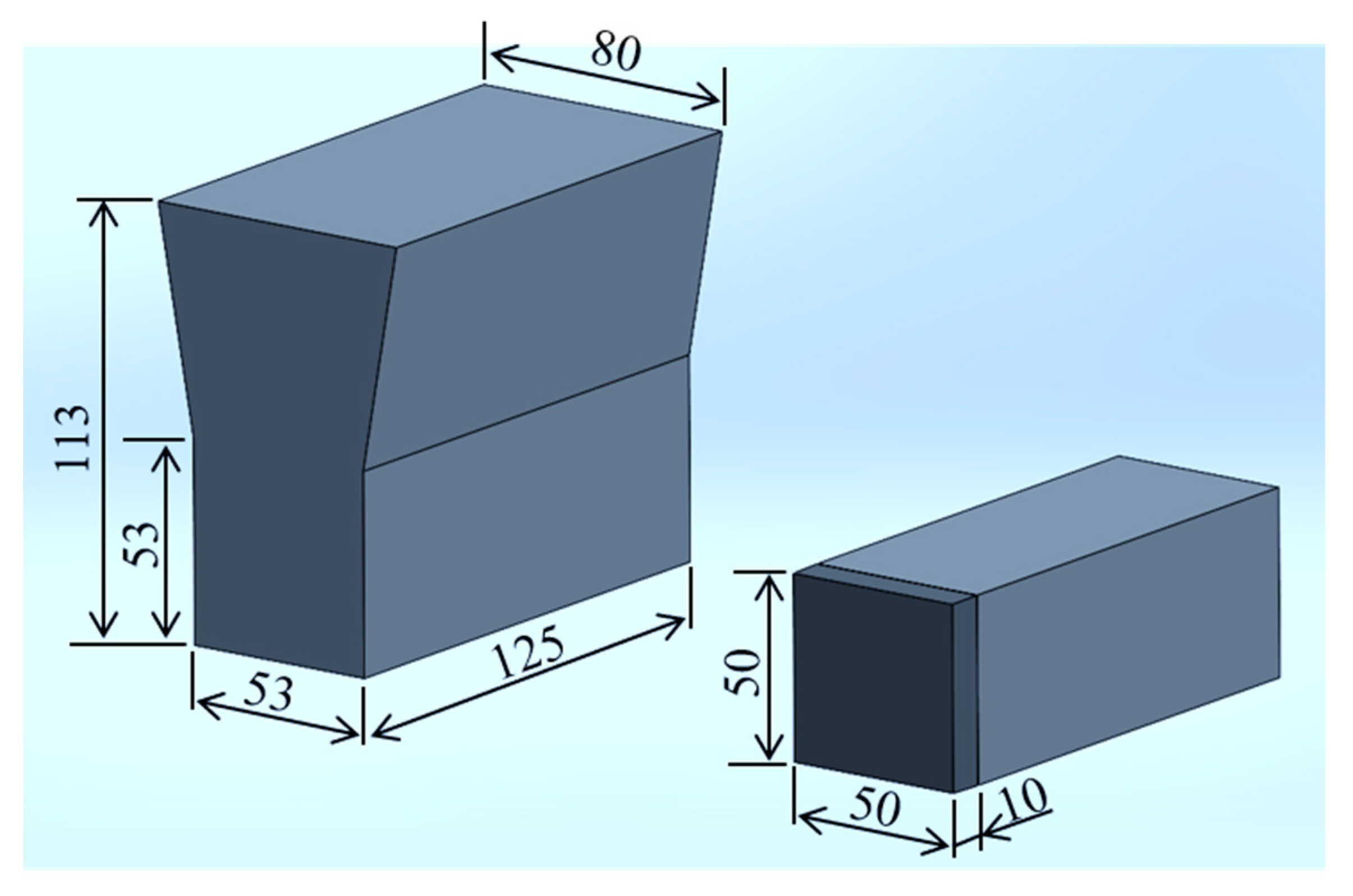

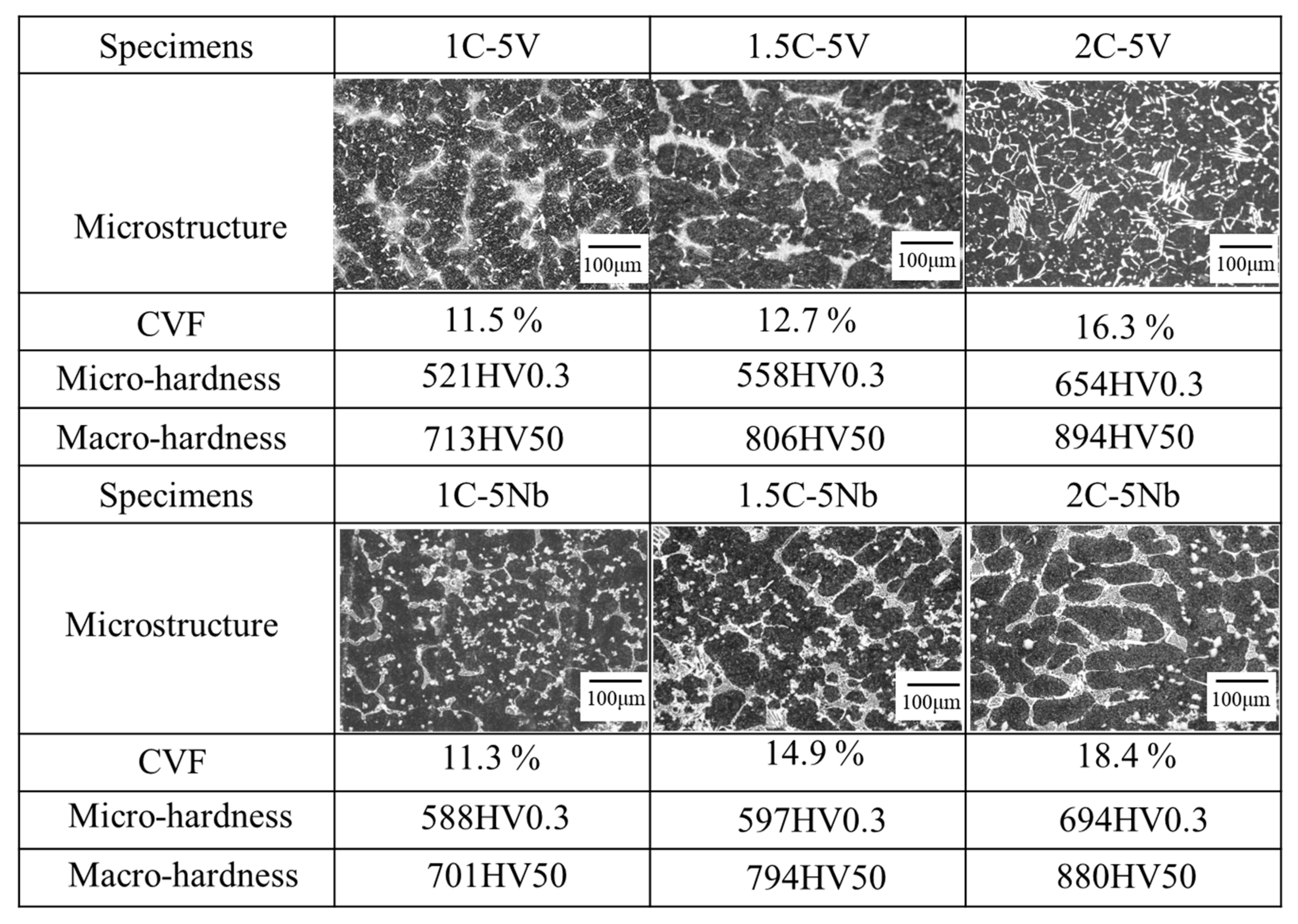
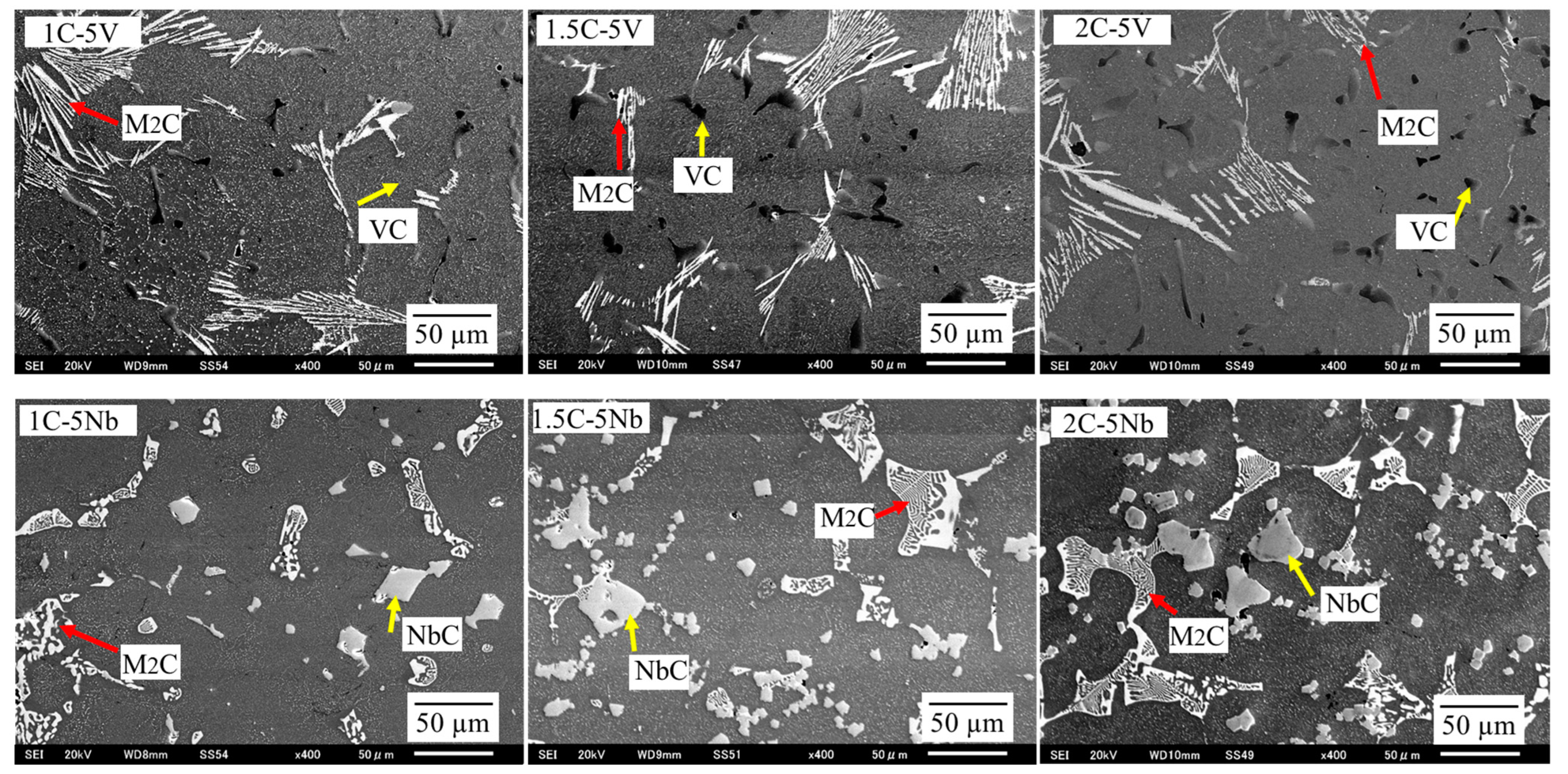

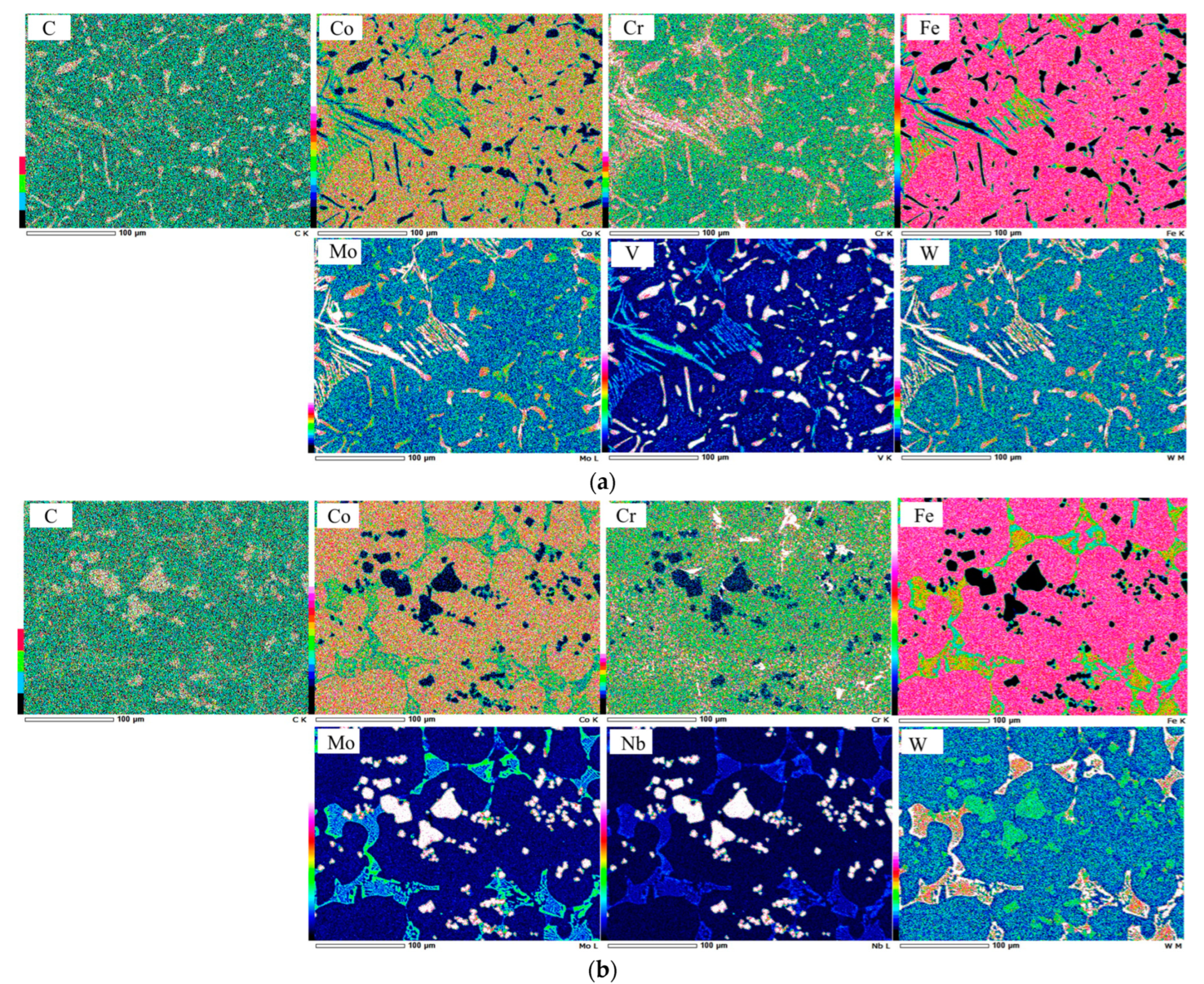
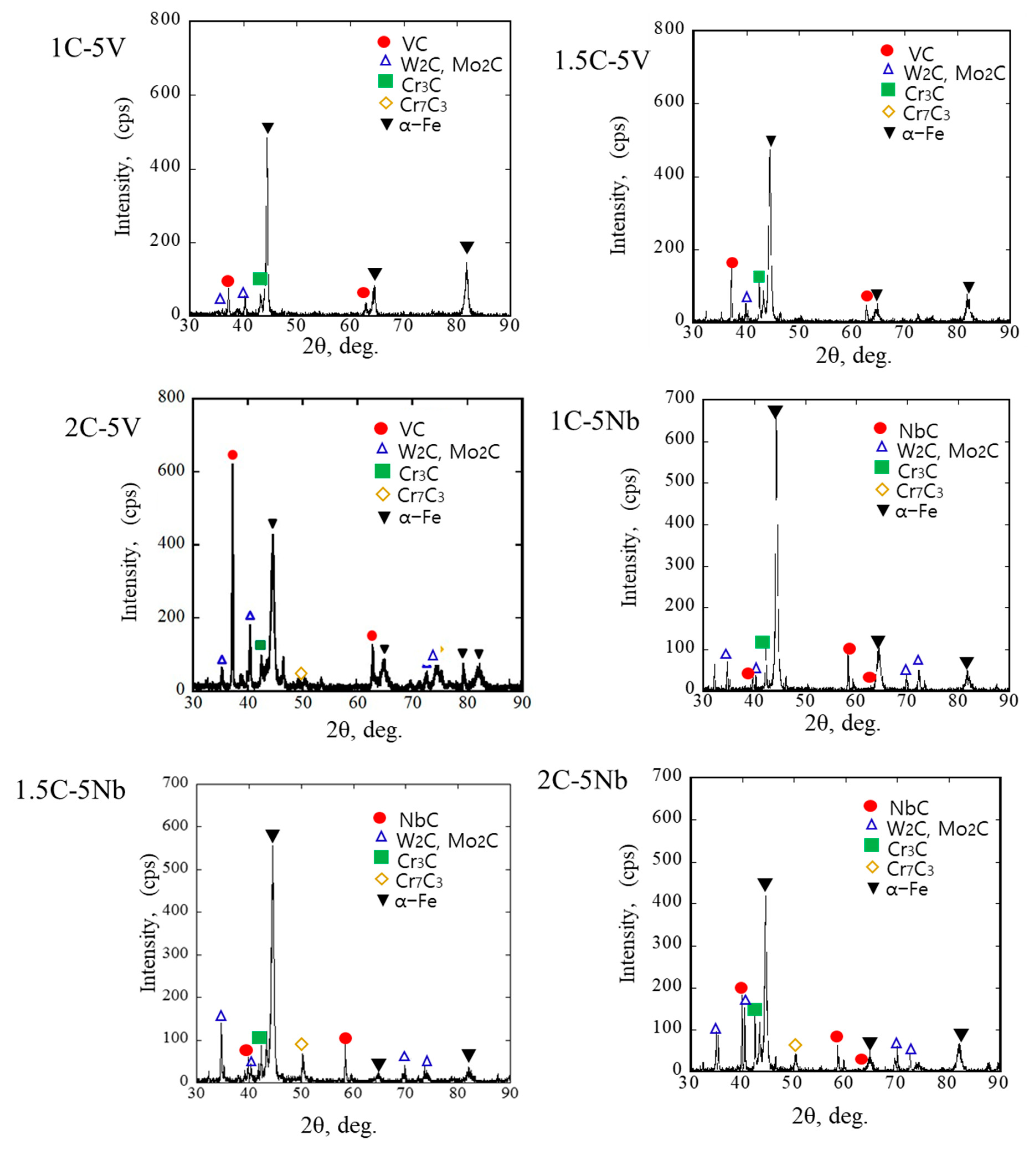
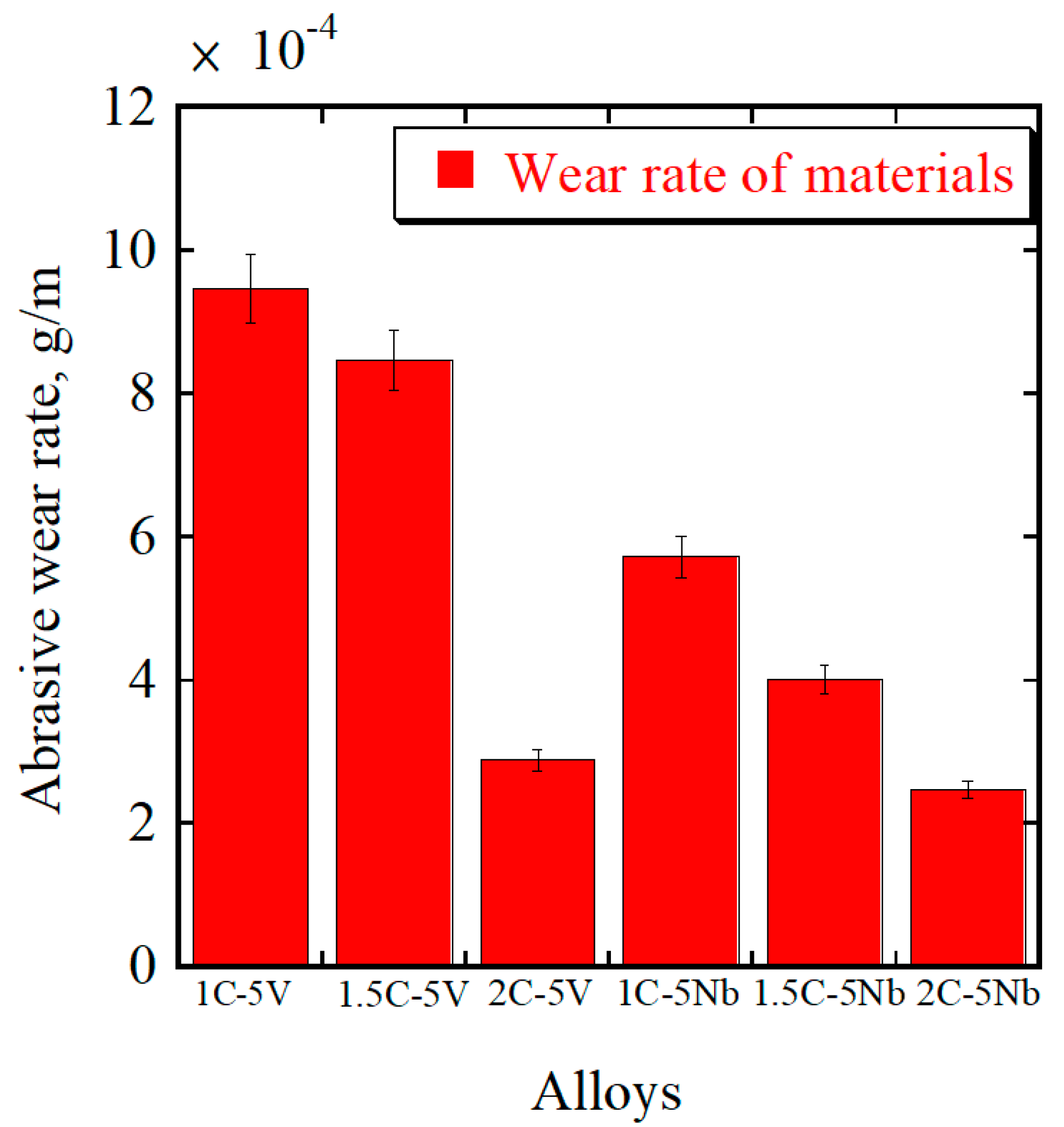
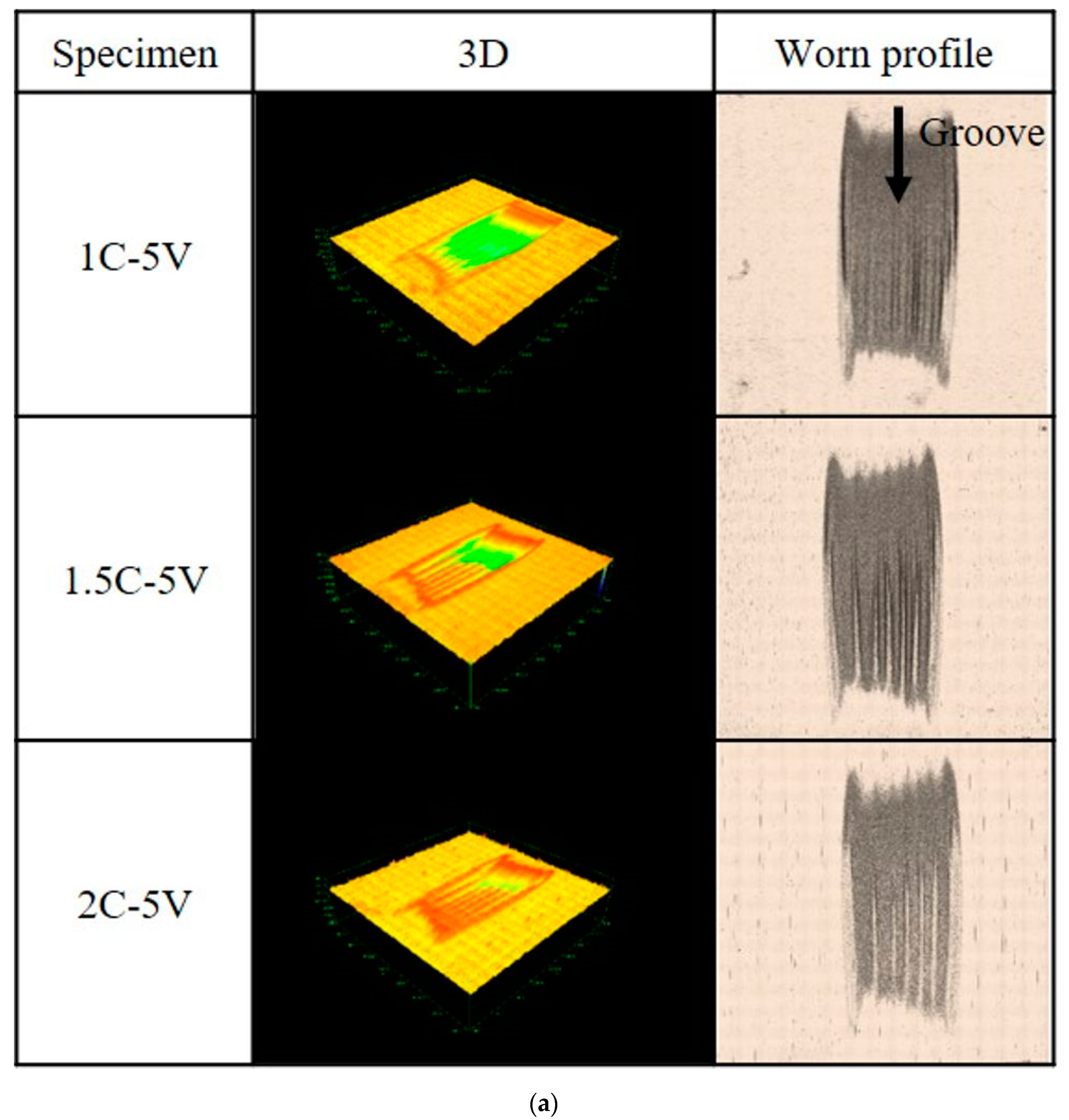


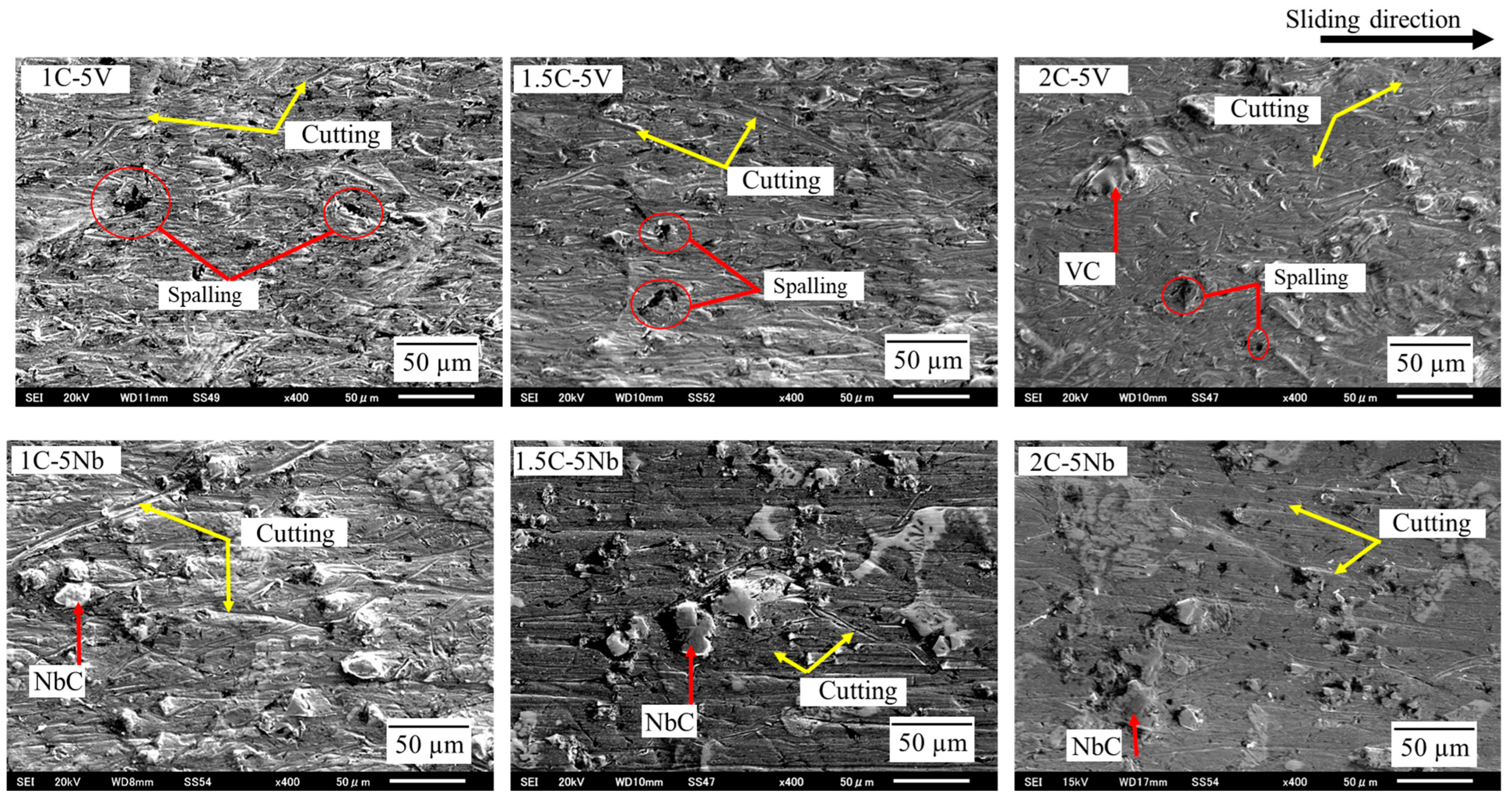
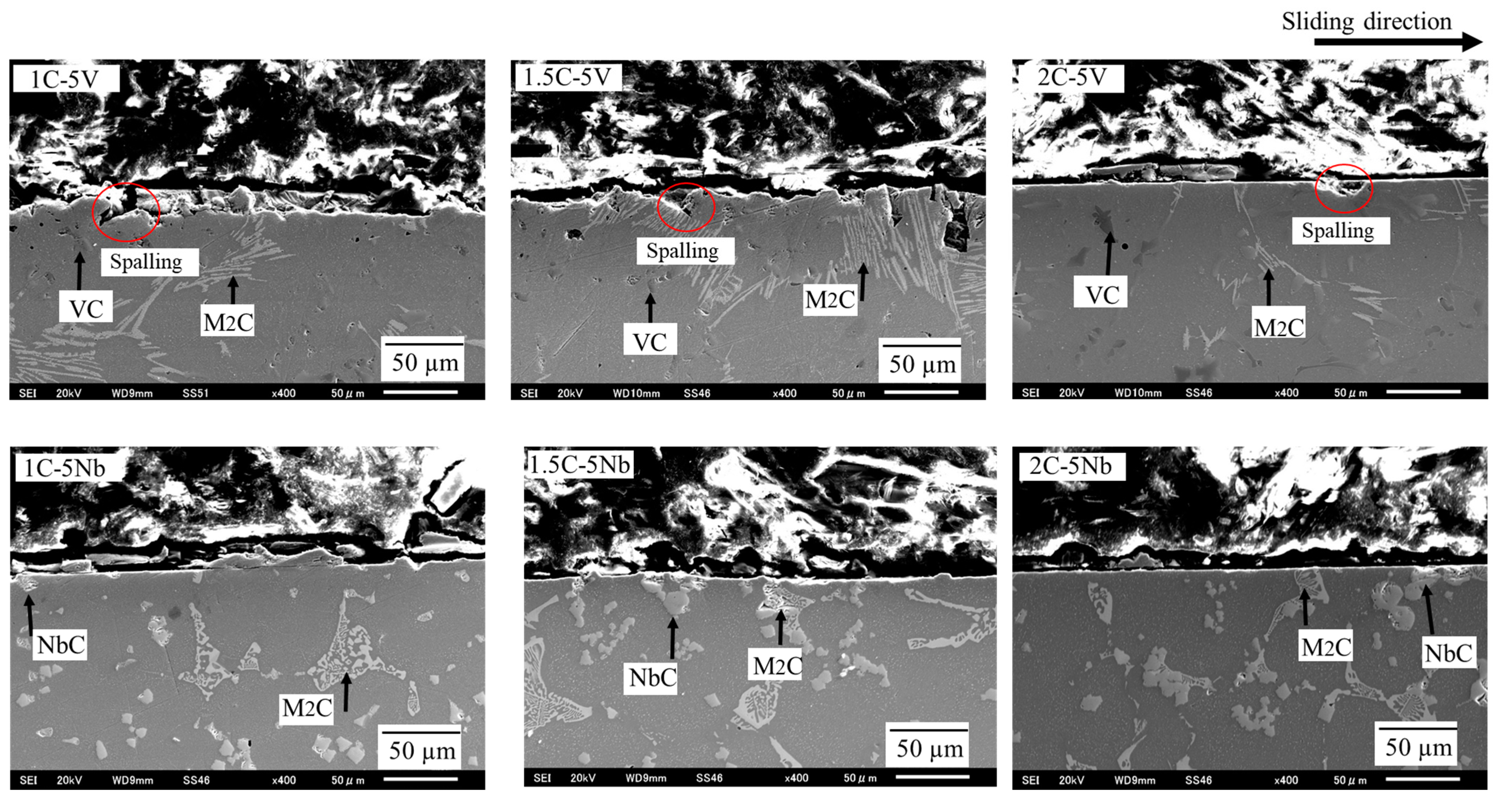
| Alloy | C | Cr | Mo | W | Co | V | Nb | Fe |
|---|---|---|---|---|---|---|---|---|
| 1C-5V | 1.12 | 4.89 | 5.02 | 4.97 | 4.89 | 5.15 | - | Bal. |
| 1.5C-5V | 1.52 | 4.85 | 5.10 | 5.03 | 4.96 | 5.01 | - | Bal. |
| 2C-5V | 1.92 | 4.84 | 5.07 | 4.90 | 4.42 | 4.79 | - | Bal. |
| 1C-5Nb | 0.97 | 5.06 | 5.21 | 5.10 | 5.07 | - | 5.06 | Bal. |
| 1.5C-5Nb | 1.39 | 5.22 | 4.97 | 5.14 | 5.07 | - | 4.89 | Bal. |
| 2C-5Nb | 1.90 | 5.03 | 5.01 | 5.03 | 4.87 | - | 4.91 | Bal. |
Disclaimer/Publisher’s Note: The statements, opinions and data contained in all publications are solely those of the individual author(s) and contributor(s) and not of MDPI and/or the editor(s). MDPI and/or the editor(s) disclaim responsibility for any injury to people or property resulting from any ideas, methods, instructions or products referred to in the content. |
© 2023 by the authors. Licensee MDPI, Basel, Switzerland. This article is an open access article distributed under the terms and conditions of the Creative Commons Attribution (CC BY) license (https://creativecommons.org/licenses/by/4.0/).
Share and Cite
Purba, R.H.; Shimizu, K.; Kusumoto, K.; Gaqi, Y.; Huq, M.J. A Study of the Three-Body Abrasive Wear Resistance of 5V/5Nb-5Cr-5Mo-5W-5Co-Fe Multicomponent Cast Alloys with Different Carbon Percentages. Materials 2023, 16, 3102. https://doi.org/10.3390/ma16083102
Purba RH, Shimizu K, Kusumoto K, Gaqi Y, Huq MJ. A Study of the Three-Body Abrasive Wear Resistance of 5V/5Nb-5Cr-5Mo-5W-5Co-Fe Multicomponent Cast Alloys with Different Carbon Percentages. Materials. 2023; 16(8):3102. https://doi.org/10.3390/ma16083102
Chicago/Turabian StylePurba, Riki Hendra, Kazumichi Shimizu, Kenta Kusumoto, Yila Gaqi, and Mohammad Jobayer Huq. 2023. "A Study of the Three-Body Abrasive Wear Resistance of 5V/5Nb-5Cr-5Mo-5W-5Co-Fe Multicomponent Cast Alloys with Different Carbon Percentages" Materials 16, no. 8: 3102. https://doi.org/10.3390/ma16083102
APA StylePurba, R. H., Shimizu, K., Kusumoto, K., Gaqi, Y., & Huq, M. J. (2023). A Study of the Three-Body Abrasive Wear Resistance of 5V/5Nb-5Cr-5Mo-5W-5Co-Fe Multicomponent Cast Alloys with Different Carbon Percentages. Materials, 16(8), 3102. https://doi.org/10.3390/ma16083102






